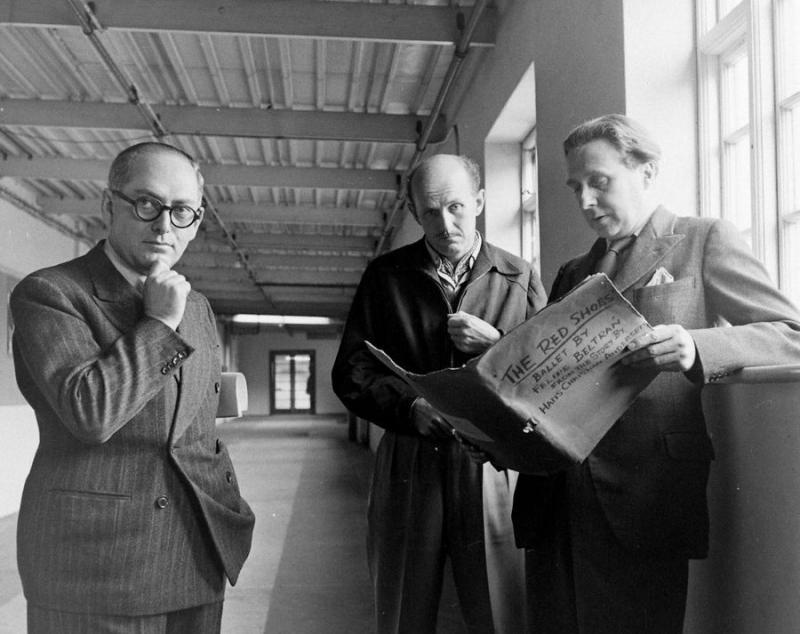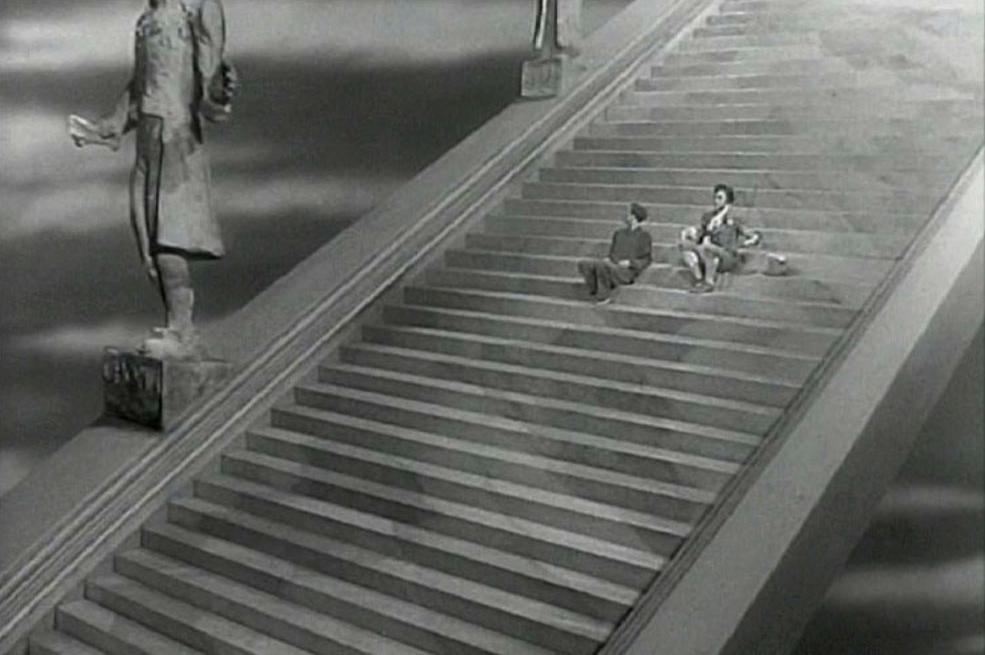Powell and Pressburger: The Composers | reviews, news & interviews
Powell and Pressburger: The Composers
Powell and Pressburger: The Composers
Two musicians, both largely forgotten, gave the duo's films much of their power

Unlike, say, Hitchcock and Bernard Herrmann, Michael Powell’s working relationships with musicians were cordial, particularly his collaborations with composers Allan Gray and Brian Easdale.
Gray, born Józef Żmigrod in Poland in 1902, had met Emeric Pressburger while working for UFA in the Weimar Republic, their paths crossing again in the early 1940s. Fleeing Nazi Germany for the UK in 1934, Gray was briefly interned as an enemy alien on the Isle of Man after war broke out, Vaughan Williams among those calling for his release as “a musician of distinction”.
Gray subsequently provided music for The Life and Death of Colonel Blimp, A Canterbury Tale, I Know Where I’m Going!, and A Matter of Life and Death. Powell’s memoir A Life in Movies gives us a sense of Gray’s strengths and limitations: “… his was film music in the traditional way, applied on, mixed into the soundtrack and the dialogue of the actors, like rich glazing on a ham.”
 This is surely too harsh: fifty pages earlier, Powell praises the “delightful” Gray’s “sympathy and skilful orchestrations”, highlighting the ostinato piano motif which accompanies the moving staircase in A Matter of Life and Death (pictured right), later recycled by Patrick Keiller in his Robinson in Space (1997). Gray extracts maximum mileage from this disquieting, mechanical theme, its proto-minimalist repetitions mirroring David Niven’s exasperation as he struggles to choose a defence counsel. The theatrical organ flourish introducing Abraham Sofaer’s celestial judge is another highlight.
This is surely too harsh: fifty pages earlier, Powell praises the “delightful” Gray’s “sympathy and skilful orchestrations”, highlighting the ostinato piano motif which accompanies the moving staircase in A Matter of Life and Death (pictured right), later recycled by Patrick Keiller in his Robinson in Space (1997). Gray extracts maximum mileage from this disquieting, mechanical theme, its proto-minimalist repetitions mirroring David Niven’s exasperation as he struggles to choose a defence counsel. The theatrical organ flourish introducing Abraham Sofaer’s celestial judge is another highlight.
The scores written for A Canterbury Tale and I Know Where I’m Going show Gray’s gift for skilled pastiche; the earlier film’s bucolic folksiness married with a luminous transcendence which recalls Vaughan Williams. And Gray’s viscerally exciting storm music adds much to the impact of I Know Where I’m Going!’s sea scenes. Gray took British citizenship after the war and continued to compose for films into the 1950s, his most famous post-P&P score being John Huston’s The African Queen. He died in 1973.
 Brian Easdale (1909-1995) was a prize-winning RCM graduate whose early career took in arranging and orchestrating early works by Britten. Military service saw him posted to Ceylon and India, composing music for documentaries, and a fascination with what we’d now term "world music" (plus a passing acquaintance with author Rumer Goden) led Powell and Pressburger to ask him to write music for a dance sequence in Black Narcissus. Easdale ended up providing the complete soundtrack and worked closely with Powell. Sequences were meticulously organised, the musically literate director preferring to rehearse and shoot with a piano track and ready access to a written score. Kathleen Byron’s death scene was “planned step by step, bar by bar”, the results incredibly effective coupled with Easdale’s heady accompaniment.
Brian Easdale (1909-1995) was a prize-winning RCM graduate whose early career took in arranging and orchestrating early works by Britten. Military service saw him posted to Ceylon and India, composing music for documentaries, and a fascination with what we’d now term "world music" (plus a passing acquaintance with author Rumer Goden) led Powell and Pressburger to ask him to write music for a dance sequence in Black Narcissus. Easdale ended up providing the complete soundtrack and worked closely with Powell. Sequences were meticulously organised, the musically literate director preferring to rehearse and shoot with a piano track and ready access to a written score. Kathleen Byron’s death scene was “planned step by step, bar by bar”, the results incredibly effective coupled with Easdale’s heady accompaniment.
Gray was hired to compose the central ballet sequence in The Red Shoes but his effort was rejected after a single piano play-through. Easdale was hastily summoned and produced a replacement at breakneck speed. Modesty prompted his suggestion that Sir Thomas Beecham should conduct the Ballet of the Red Shoes, and that much of it sounds like a beguiling mixture of Tchaikovsky, Ravel and Prokofiev isn’t a criticism – as ballet music, it’s terrific, and deservedly won the composer an Oscar for Best Original Score.
The recent Chandos recording (in a performing edition made by John Wilson) is worth acquiring, the engineers giving due prominence to the eerie howl of the Ondes Martenot. Several moments stand out: I can’t resist the doomy descending brass chords heard while Moira Shearer’s Vicky is assailed by demons, and the ballet’s quiet final minutes suggest that Easdale knew his Stravinsky well. The Red Shoes’ musical sequences are unusually credible: the musicians look as if they’re playing and not miming. Do listen out for the low brass parp heard while Marius Goring’s nervous Craster (pictured below right) apologises at the start of his first rehearsal, a gag which musicians will appreciate.
 Easdale continued to work with Powell and Pressburger during the 1950s. The former’s diary entries for 1952 and 1953 describe in detail a close collaboration with him on The Lotus of the Moon, an unrealised project based on a Hindu love story. Powell describes him at one point, perhaps unfairly, as “civilised, cultivated, brilliant and lazy”, while marvelling at Easdale’s fluency. Nothing which followed was quite as memorable, sadly, and his music for The Battle of the River Plate rarely catches fire. Still, the percussive piano riff heard over the opening titles to Powell’s Peeping Tom shows him back on form, though the film’s critical mauling harmed the careers of composer as well as director.
Easdale continued to work with Powell and Pressburger during the 1950s. The former’s diary entries for 1952 and 1953 describe in detail a close collaboration with him on The Lotus of the Moon, an unrealised project based on a Hindu love story. Powell describes him at one point, perhaps unfairly, as “civilised, cultivated, brilliant and lazy”, while marvelling at Easdale’s fluency. Nothing which followed was quite as memorable, sadly, and his music for The Battle of the River Plate rarely catches fire. Still, the percussive piano riff heard over the opening titles to Powell’s Peeping Tom shows him back on form, though the film’s critical mauling harmed the careers of composer as well as director.
Easdale provided a choral work for the consecration of the new Coventry Cathedral in 1962, inevitably overshadowed by his one-time colleague Britten’s War Requiem, and slipped into relative obscurity and spells of alcoholism. He continued to compose sporadically, producing music for radio plays, documentaries and stage productions, and there was one final collaboration with Powell, Easdale composing and conducting snippets of incidental music for 1978’s Return to the Edge of the World. He died in a Kilburn retirement home, a year after a performance of a new suite drawn from The Red Shoes had reawakened interest in his work.
The future of Arts Journalism
You can stop theartsdesk.com closing!
We urgently need financing to survive. Our fundraising drive has thus far raised £49,000 but we need to reach £100,000 or we will be forced to close. Please contribute here: https://gofund.me/c3f6033d
And if you can forward this information to anyone who might assist, we’d be grateful.

Subscribe to theartsdesk.com
Thank you for continuing to read our work on theartsdesk.com. For unlimited access to every article in its entirety, including our archive of more than 15,000 pieces, we're asking for £5 per month or £40 per year. We feel it's a very good deal, and hope you do too.
To take a subscription now simply click here.
And if you're looking for that extra gift for a friend or family member, why not treat them to a theartsdesk.com gift subscription?
more Film
 Late Shift review - life and death in an understaffed Swiss hospital
Petra Volpe directs Leonie Benesch in a compelling medical drama
Late Shift review - life and death in an understaffed Swiss hospital
Petra Volpe directs Leonie Benesch in a compelling medical drama
 The Naked Gun review - farce, slapstick and crass stupidity
Pamela Anderson and Liam Neeson put a retro spin on the Police Squad files
The Naked Gun review - farce, slapstick and crass stupidity
Pamela Anderson and Liam Neeson put a retro spin on the Police Squad files
 theartsdesk Q&A: actor Lars Eidinger on 'Dying' and loving the second half of life
The German star talks about playing the director's alter ego in a tormented family drama
theartsdesk Q&A: actor Lars Eidinger on 'Dying' and loving the second half of life
The German star talks about playing the director's alter ego in a tormented family drama
 The Fantastic Four: First Steps review - innocence regained
Marvel's original super-group return to fun, idealistic first principles
The Fantastic Four: First Steps review - innocence regained
Marvel's original super-group return to fun, idealistic first principles
 Dying review - they fuck you up, your mum and dad
Family dysfunction is at the heart of a quietly mesmerising German drama
Dying review - they fuck you up, your mum and dad
Family dysfunction is at the heart of a quietly mesmerising German drama
 theartsdesk Q&A: director Athina Rachel Tsangari on her brooding new film 'Harvest'
The Greek filmmaker talks about adapting Jim Crace's novel and putting the mercurial Caleb Landry Jones centre stage
theartsdesk Q&A: director Athina Rachel Tsangari on her brooding new film 'Harvest'
The Greek filmmaker talks about adapting Jim Crace's novel and putting the mercurial Caleb Landry Jones centre stage
 Blu-ray: The Rebel / The Punch and Judy Man
Tony Hancock's two film outings, newly remastered
Blu-ray: The Rebel / The Punch and Judy Man
Tony Hancock's two film outings, newly remastered
 The Ballad of Suzanne Césaire review - a mysterious silence
A black Caribbean Surrealist rebel obliquely remembered
The Ballad of Suzanne Césaire review - a mysterious silence
A black Caribbean Surrealist rebel obliquely remembered
 Harvest review - blood, barley and adaptation
An incandescent novel struggles to light up the screen
Harvest review - blood, barley and adaptation
An incandescent novel struggles to light up the screen
 Friendship review - toxic buddy alert
Dark comedy stars Tim Robinson as a social misfit with cringe benefits
Friendship review - toxic buddy alert
Dark comedy stars Tim Robinson as a social misfit with cringe benefits
 S/HE IS STILL HER/E - The Official Genesis P-Orridge Documentary review - a shapeshifting open window onto a counter-cultural radical
Intimate portrait of the Throbbing Gristle & Psychic TV antagonist
S/HE IS STILL HER/E - The Official Genesis P-Orridge Documentary review - a shapeshifting open window onto a counter-cultural radical
Intimate portrait of the Throbbing Gristle & Psychic TV antagonist
 Blu-ray: Heart of Stone
Deliciously dark fairy tale from post-war Eastern Europe
Blu-ray: Heart of Stone
Deliciously dark fairy tale from post-war Eastern Europe

Add comment